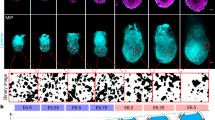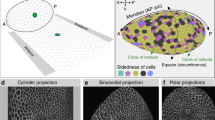Abstract
Large gaps in basement membrane occur at sites of cell invasion and tissue remodelling in development and cancer. Though never followed directly in vivo, basement membrane dissolution or reduced synthesis have been postulated to create these gaps. Using landmark photobleaching and optical highlighting of laminin and type IV collagen, we find that a new mechanism, basement membrane sliding, underlies basement membrane gap enlargement during uterine–vulval attachment in Caenorhabditis elegans. Laser ablation and mutant analysis reveal that the invaginating vulval cells promote basement membrane movement. Further, an RNA interference and expression screen identifies the integrin INA-1/PAT-3 and VAB-19, homologue of the tumour suppressor Kank, as regulators of basement membrane opening. Both concentrate within vulval cells at the basement membrane gap boundary and halt expansion of the shifting basement membrane. Basement membrane sliding followed by targeted adhesion represents a new mechanism for creating precise basement membrane breaches that can be used by cells to break down compartment boundaries.
This is a preview of subscription content, access via your institution
Access options
Subscribe to this journal
Receive 12 print issues and online access
$209.00 per year
only $17.42 per issue
Buy this article
- Purchase on Springer Link
- Instant access to full article PDF
Prices may be subject to local taxes which are calculated during checkout






Similar content being viewed by others
Change history
28 October 2013
In the version of this Article originally published online, the citation of Nature Protocols at the end of the 'Optical highlighting (photoconversion) of basement membrane components' section in the Methods was incorrect. It has been corrected in all online versions of the Article.
References
Rowe, R. G. & Weiss, S. J. Navigating ECM barriers at the invasive front: the cancer cell–stroma interface. Annu. Rev. Cell Dev. Biol. 25, 567–595 (2009).
Sherwood, D. R. Cell invasion through basement membranes: an anchor of understanding. Trends Cell Biol. 16, 250–256 (2006).
Kalluri, R. Basement membranes: structure, assembly and role in tumour angiogenesis. Nat. Rev. Cancer 3, 422–433 (2003).
Even-Ram, S. & Yamada, K. M. Cell migration in 3D matrix. Curr. Opin. Cell Biol. 17, 524–532 (2005).
Rowe, R. G. & Weiss, S. J. Breaching the basement membrane: who, when and how? Trends. Cell Biol. 18, 560–574 (2008).
Nourshargh, S., Hordijk, P. L. & Sixt, M. Breaching multiple barriers: leukocyte motility through venular walls and the interstitium. Nat. Rev. Mol. Cell Biol. 11, 366–378 (2010).
Nakaya, Y., Sukowati, E. W., Wu, Y. & Sheng, G. RhoA and microtubule dynamics control cell–basement membrane interaction in EMT during gastrulation. Nat. Cell Biol. 10, 765–775 (2008).
Sherwood, D. R. & Sternberg, P. W. Anchor cell invasion into the vulval epithelium in C. elegans. Dev. Cell 5, 21–31 (2003).
Srivastava, A., Pastor-Pareja, J. C., Igaki, T., Pagliarini, R. & Xu, T. Basement membrane remodeling is essential for Drosophila disc eversion and tumour invasion. Proc. Natl Acad. Sci. USA 104, 2721–2726 (2007).
Barsky, S. H., Siegal, G. P., Jannotta, F. & Liotta, L. A. Loss of basement membrane components by invasive tumours but not by their benign counterparts. Lab. Invest. 49, 140–147 (1983).
Flug, M. & Kopf-Maier, P. The basement membrane and its involvement in carcinoma cell invasion. Acta. Anat. (Basel) 152, 69–84 (1995).
Frei, J. V. The fine structure of the basement membrane in epidermal tumours. J. Cell Biol. 15, 335–342 (1962).
Matus, D. Q. et al. In vivo identification of regulators of cell invasion across basement membranes. Sci. Signal. 3, ra35 (2010).
Spaderna, S. et al. A transient, EMT-linked loss of basement membranes indicates metastasis and poor survival in colorectal cancer. Gastroenterology 131, 830–840 (2006).
Cavallo-Medved, D. et al. Live-cell imaging demonstrates extracellular matrix degradation in association with active cathepsin B in caveolae of endothelial cells during tube formation. Exp. Cell Res. 315, 1234–1246 (2009).
Garbisa, S., Kniska, K., Tryggvason, K., Foltz, C. & Liotta, L. A. Quantitation of basement membrane collagen degradation by living tumour cells in vitro. Cancer Lett. 9, 359–366 (1980).
Hotary, K., Li, X. Y., Allen, E., Stevens, S. L. & Weiss, S. J. A cancer cell metalloprotease triad regulates the basement membrane transmigration program. Genes Dev. 20, 2673–2686 (2006).
Overall, C. M. & Kleifeld, O. Tumour microenvironment—opinion: validating matrix metalloproteinases as drug targets and anti-targets for cancer therapy. Nat. Rev. Cancer 6, 227–239 (2006).
Page-McCaw, A., Ewald, A. J. & Werb, Z. Matrix metalloproteinases and the regulation of tissue remodelling. Nat. Rev. Mol. Cell Biol. 8, 221–233 (2007).
Sameni, M., Dosescu, J., Yamada, K. M., Sloane, B. F. & Cavallo-Medved, D. Functional live-cell imaging demonstrates that beta1-integrin promotes type IV collagen degradation by breast and prostate cancer cells. Mol. Imaging 7, 199–213 (2008).
Sherwood, D. R., Butler, J. A., Kramer, J. M. & Sternberg, P. W. FOS-1 promotes basement-membrane removal during anchor-cell invasion in C. elegans. Cell 121, 951–962 (2005).
Xu, J. et al. Proteolytic exposure of a cryptic site within collagen type IV is required for angiogenesis and tumor growth in vivo. J. Cell Biol. 154, 1069–1079 (2001).
Liotta, L. A., Rao, N. C., Barsky, S. H. & Bryant, G. The laminin receptor and basement membrane dissolution: role in tumour metastasis. Ciba. Found. Symp. 108, 146–162 (1984).
Newman, A. P. & Sternberg, P. W. Coordinated morphogenesis of epithelia during development of the Caenorhabditis elegans uterine–vulval connection. Proc. Natl Acad. Sci. USA 93, 9329–9333 (1996).
Ding, M. et al. The cell signalling adaptor protein EPS-8 is essential for C. elegans epidermal elongation and interacts with the ankyrin repeat protein VAB-19. PLoS One 3, e3346 (2008).
Kakinuma, N., Zhu, Y., Wang, Y., Roy, B. C. & Kiyama, R. Kank proteins: structure, functions and diseases. Cell Mol. Life Sci. 66, 2651–2659 (2009).
Newman, A. P., White, J. G. & Sternberg, P. W. Morphogenesis of the C. elegans hermaphrodite uterus. Development 122, 3617–3626 (1996).
Lints, R. & Hall, D. H. Reproductive system, egglaying apparatus. WormAtlas doi:10.3908/wormatlas.1.24 (2010).
Kao, G., Huang, C. C., Hedgecock, E. M., Hall, D. H. & Wadsworth, W. G. The role of the laminin beta subunit in laminin heterotrimer assembly and basement membrane function and development in C. elegans. Dev. Biol. 290, 211–219 (2006).
Ziel, J. W., Hagedorn, E. J., Audhya, A. & Sherwood, D. R. UNC-6 (netrin) orients the invasive membrane of the anchor cell in C. elegans. Nat. Cell Biol. 11, 183–189 (2009).
Fitzgerald, M. C. & Schwarzbauer, J. E. Importance of the basement membrane protein SPARC for viability and fertility in Caenorhabditis elegans. Curr. Biol. 8, 1285–1288 (1998).
Kramer, J. M. Basement membranes. WormBook 1–15 (2005).
Hagedorn, E. J. et al. Integrin acts upstream of netrin signalling to regulate formation of the anchor cell’s invasive membrane in C. elegans. Dev. Cell 17, 187–198 (2009).
Kimble, J. & Hirsh, D. The postembryonic cell lineages of the hermaphrodite and male gonads in Caenorhabditis elegans. Dev. Biol. 70, 396–417 (1979).
Liu, J., Tzou, P., Hill, R. J. & Sternberg, P. W. Structural requirements for the tissue-specific and tissue-general functions of the Caenorhabditis elegans epidermal growth factor LIN-3. Genetics 153, 1257–1269 (1999).
Gurskaya, N. G. et al. Engineering of a monomeric green-to-red photoactivatable fluorescent protein induced by blue light. Nat. Biotechnol. 24, 461–465 (2006).
Baum, P. D. & Garriga, G. Neuronal migrations and axon fasciculation are disrupted in ina-1 integrin mutants. Neuron 19, 51–62 (1997).
Yurchenco, P. D., Amenta, P. S. & Patton, B. L. Basement membrane assembly, stability and activities observed through a developmental lens. Matrix Biol. 22, 521–538 (2004).
Leptin, M., Bogaert, T., Lehmann, R. & Wilcox, M. The function of PS integrins during Drosophila embryogenesis. Cell 56, 401–408 (1989).
Marlin, S. D., Morton, C. C., Anderson, D. C. & Springer, T. A. LFA-1 immunodeficiency disease. Definition of the genetic defect and chromosomal mapping of alpha and beta subunits of the lymphocyte function-associated antigen 1 (LFA-1) by complementation in hybrid cells. J. Exp. Med. 164, 855–867 (1986).
Ding, M., Goncharov, A., Jin, Y. & Chisholm, A. D. C. elegans ankyrin repeat protein VAB-19 is a component of epidermal attachment structures and is essential for epidermal morphogenesis. Development 130, 5791–5801 (2003).
Madsen, C. D. & Sahai, E. Cancer dissemination—lessons from leukocytes. Dev. Cell 19, 13–26 (2010).
Wolf, K. et al. Multi-step pericellular proteolysis controls the transition from individual to collective cancer cell invasion. Nat. Cell Biol. 9, 893–904 (2007).
Altun, Z. F. & Hall, D. H. Muscle system, somatic muscle. WormAtlasdoi:10.3908/wormatlas.1.7, (2009).
Cox, E. A., Tuskey, C. & Hardin, J. Cell adhesion receptors in C. elegans. J. Cell Sci. 117, 1867–1870 (2004).
Leardkamolkarn, V. & Abrahamson, D. R. Binding of intravenously injected antibodies against laminin to developing and mature endocrine glands. Cell Tissue Res. 251, 171–181 (1988).
Price, R. G. & Spiro, R. G. Studies on the metabolism of the renal glomerular basement membrane. Turnover measurements in the rat with the use of radiolabelled amino acids. J. Biol. Chem. 252, 8597–8602 (1977).
Trier, J. S., Allan, C. H., Abrahamson, D. R. & Hagen, S. J. Epithelial basement membrane of mouse jejunum. Evidence for laminin turnover along the entire crypt–villus axis. J. Clin. Invest. 86, 87–95 (1990).
Zamir, E. A., Rongish, B. J. & Little, C. D. The ECM moves during primitive streak formation—computation of ECM versus cellular motion. PLoS Biol. 6 e247 (2008).
Hanahan, D. & Weinberg, R. A. The hallmarks of cancer. Cell 100, 57–70 (2000).
Brenner, S. The genetics of Caenorhabditis elegans. Genetics 77, 71–94 (1974).
Fraser, A. G. et al. Functional genomic analysis of C. elegans chromosome I by systematic RNA interference. Nature 408, 325–330 (2000).
Rual, J. F. et al. Toward improving Caenorhabditis elegans phenome mapping with an ORFeome-based RNAi library. Genome Res. 14, 2162–2168 (2004).
Green, R. A. et al. Expression and imaging of fluorescent proteins in the C. elegans gonad and early embryo. Methods Cell Biol. 85, 179–218 (2008).
Hagedorn, E. & Sherwood, D. Optically highlighting basement membrane components C. elegans. Protocol Exchange 10.1038/protex.2011.230 (2011).
Acknowledgements
We are grateful to A. Chisholm for the vab-19::GFP vector; J. Culotti for the mig-6(ev700)strain; J. Schwarzbauer for the pat-3 HA– β-tail vector; S. Mitani for the deletion mutant (tm1291), S. Johnson of the Duke University LMCF for imaging advice, the Caenorhabditis Genetic Center for strains, and A. Schindler, D. Matus and L. Lilley for comments on the manuscript. This work was supported by a Basil O’Connor Scholars Research Award, The Pew Scholars Program in the Biomedical Sciences and NIH grants GM079320 and GM079320-03S1 to D.R.S., HD027211 to J.M.K. and a JSPS Postdoctoral Fellow for Research Abroad Award to S.I.
Author information
Authors and Affiliations
Contributions
S.I. carried out most of the experiments. All other authors carried out particular subsets of experiments or developed key reagents. D.R.S. and S.I. designed the project and D.R.S., S.I., E.J.H. and M.A.M. wrote the manuscript.
Corresponding author
Ethics declarations
Competing interests
The authors declare no competing financial interests.
Supplementary information
Supplementary Information
Supplementary Information (PDF 1501 kb)
Supplementary Information
Supplementary Movie 1 (MOV 4626 kb)
Supplementary Information
Supplementary Movie 2 (MOV 4016 kb)
Supplementary Information
Supplementary Movie 3 (MOV 6406 kb)
Supplementary Information
Supplementary Movie 4 (MOV 7824 kb)
Supplementary Information
Supplementary Movie 5 (MOV 2591 kb)
Rights and permissions
About this article
Cite this article
Ihara, S., Hagedorn, E., Morrissey, M. et al. Basement membrane sliding and targeted adhesion remodels tissue boundaries during uterine–vulval attachment in Caenorhabditis elegans. Nat Cell Biol 13, 641–651 (2011). https://doi.org/10.1038/ncb2233
Received:
Accepted:
Published:
Issue Date:
DOI: https://doi.org/10.1038/ncb2233
This article is cited by
-
CRISPR-Cas9-mediated labelling of the C-terminus of human laminin β1 leads to secretion inhibition
BMC Research Notes (2020)
-
Cancer-associated fibroblasts induce metalloprotease-independent cancer cell invasion of the basement membrane
Nature Communications (2017)
-
Live-cell confocal microscopy and quantitative 4D image analysis of anchor-cell invasion through the basement membrane in Caenorhabditis elegans
Nature Protocols (2017)
-
Kank2 activates talin, reduces force transduction across integrins and induces central adhesion formation
Nature Cell Biology (2016)
-
Evolutionary and developmental analysis reveals KANK genes were co-opted for vertebrate vascular development
Scientific Reports (2016)



